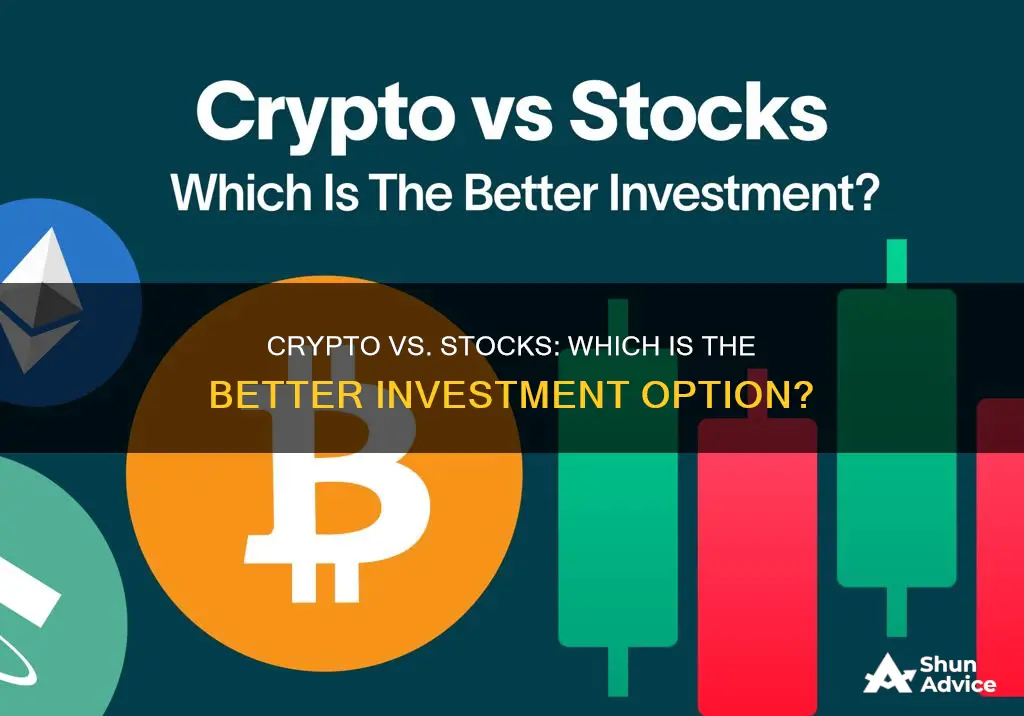
Cryptocurrency and stocks are two very distinct asset classes with their own sets of risks and rewards. Stocks are generally considered more stable investments since they represent ownership in a company and are backed by its assets and cash flow. On the other hand, cryptocurrencies are highly volatile and speculative, with their prices driven mainly by market sentiment and the greater fool theory of investing. While crypto offers the potential for substantial gains, it lacks the intrinsic value and long-term track record of stocks. However, some investors are increasingly allocating more funds to crypto than stocks, indicating a growing interest in digital assets. This shift is largely driven by novice investors who may be experiencing FOMO (fear of missing out). As crypto and stocks converge in the new digital economy, investors must carefully weigh the pros and cons of each asset class and make decisions aligned with their risk tolerance and financial goals.
| Characteristics | Values |
|---|---|
| Accessibility | Stocks are generally traded during set business hours, whereas crypto markets are open 24/7. |
| Regulation | Stocks are securities regulated by the SEC, while many cryptocurrencies are not structured as securities. |
| Ownership | Stocks represent ownership of a company, while cryptocurrencies are utility tokens or stores of value. |
| Issuance | Companies can issue new stocks, but crypto supply is often capped by code. |
| Trading | Stocks are usually purchased with fiat currency, but crypto trades often involve trading pairs of two cryptocurrencies. |
| Liquidity | Both stocks and crypto can suffer from low liquidity, especially when dealing with smaller companies or coins. |
| Transparency | Publicly traded companies are legally required to maintain transparency, while crypto projects are not subject to the same regulatory scrutiny. |
| Returns | Stocks have a long history of solid returns, while crypto is extremely volatile and driven by speculation. |
| Value | Stocks have intrinsic value as they represent ownership of a company, whereas crypto has no intrinsic value. |
| Risk | Stocks are generally safer due to their long-term track record, regulation, and backing by company assets. |
What You'll Learn

Crypto's volatility vs. stocks' relative safety
Cryptos Volatility vs. Stocks Relative Safety
Cryptocurrency and stocks are two distinct asset classes with fundamental differences. While both have their pros and cons, stocks are generally considered safer investments due to their long history of solid returns, intrinsic value, and regulatory oversight. On the other hand, cryptocurrencies are highly volatile and lack the backing of tangible assets, making them riskier but potentially more rewarding.
Volatility and Risk
Cryptocurrencies, such as Bitcoin and Ethereum, have experienced extreme volatility in their relatively young existence. They are not backed by any hard assets or cash flow, and their prices are solely determined by market speculation and sentiment. As a result, fortunes can be made and lost quickly, and their values can fluctuate drastically in a short period. This volatility makes cryptocurrencies unsuitable for short-term investors or those with a low-risk tolerance.
In contrast, stocks have a long track record of producing solid investment returns over time. While individual stocks can be volatile, a diversified portfolio of stocks tends to benefit from reduced risk. Stocks represent ownership interests in companies and are backed by their assets, cash flow, and future earnings power, creating intrinsic value. This intrinsic value provides a basis for valuation and makes stocks safer investments than cryptocurrencies.
Regulatory Landscape
Stocks are heavily regulated by government agencies such as the Securities and Exchange Commission (SEC) in the United States. Companies are required to disclose certain information, provide regular financial updates, and adhere to specific rules and regulations. This regulatory framework provides important investor protections and transparency.
Cryptocurrencies, on the other hand, are subject to varying degrees of regulatory scrutiny across different jurisdictions. While some countries, like El Salvador, have embraced Bitcoin, others, like China, have banned it altogether. The regulatory landscape for cryptocurrencies is still evolving, and the lack of consistent regulation adds to the risk associated with these digital assets.
Investor Considerations
When deciding between investing in cryptocurrencies or stocks, it is essential to consider your time horizon and risk tolerance. Stocks are generally better suited for long-term investment plans, allowing investors to ride out short-term losses. A diversified portfolio of stocks can provide a safer option, especially for those with a lower risk tolerance.
Cryptocurrencies, due to their high volatility, are better suited for traders who can leave their money invested for the long term and are comfortable with the associated risks. Even within the crypto market, some cryptocurrencies are more stable than others. For example, stablecoins are specialized cryptocurrencies designed to minimize price volatility by being backed by reserve assets.
Portfolio Management
Investors do not need to choose exclusively between cryptocurrencies and stocks. A well-diversified portfolio can include both assets, with stocks forming the majority of the portfolio and cryptocurrencies allocated a smaller portion, such as 5% or less. This approach allows investors to benefit from the potential gains of cryptocurrencies while mitigating the risk of a complete loss if crypto values plummet.
In conclusion, while cryptocurrencies offer the potential for substantial gains, they come with significant risks and volatility. Stocks, on the other hand, provide a safer option with a long history of solid returns, intrinsic value, and regulatory oversight. The choice between investing in cryptocurrencies or stocks ultimately depends on an investor's risk tolerance, time horizon, and financial goals.
Altcoin Investing: How to Spot the Next Big Thing
You may want to see also

Crypto's lack of regulation vs. stocks' government oversight
Cryptos Lack of Regulation vs. Stocks Government Oversight
The debate surrounding the regulation of cryptocurrencies and the government oversight of stocks has been a topic of discussion for investors and policymakers alike. On the one hand, cryptocurrencies operate in a decentralised and unregulated environment, while on the other hand, stocks are subject to strict government regulations and oversight. So, what are the implications of this difference, and which type of investment does it favour?
Cryptocurrencies lack of regulation has been a cause for concern for many investors. Without regulatory oversight, crypto investors face higher risks of security breaches, hacks, and criminal activities. Additionally, the lack of regulation means that there is no guarantee of consumer protection in the event of fraud or malpractice. This unregulated environment also allows for the proliferation of scams and fraudulent crypto projects, with little to no recourse for affected investors.
In contrast, stocks are subject to stringent government oversight and regulations, which aim to protect investors and ensure market integrity. For example, in the United States, the Securities and Exchange Commission (SEC) is responsible for regulating the securities market and protecting investors. The SEC oversees securities trading, disclosures of public companies, and the activities of registered entities such as investment advisors and broker-dealers. This regulatory framework provides investors with a level of confidence and protection when investing in the stock market.
However, despite the apparent benefits of government oversight, some investors view the lack of regulation in cryptocurrencies as an advantage. The decentralised nature of crypto means that it is not subject to the same level of government intervention and control as stocks. This provides investors with more freedom and autonomy when making investment decisions. Additionally, the lack of regulation can also foster innovation and allow for faster transactions and lower fees.
Nonetheless, the lack of regulation in cryptocurrencies has led to calls for more standardised global regulations. The International Monetary Fund (IMF), for instance, has emphasised the need for "robust, comprehensive, globally consistent crypto regulation and supervision". This is particularly important as the cross-border nature of crypto limits the effectiveness of uncoordinated national approaches. A global regulatory framework could help address concerns about market integrity, user protection, and financial stability.
In conclusion, the debate surrounding cryptos lack of regulation and stocks government oversight is a complex one. While the lack of regulation in cryptocurrencies can be advantageous in terms of freedom and innovation, it also poses significant risks to investors. On the other hand, government oversight of stocks provides a level of protection and confidence for investors, but some may view it as a hindrance to their investment strategies. Ultimately, the decision to invest in cryptos or stocks depends on an individual's risk tolerance, investment goals, and personal preferences.
Understanding Cryptocurrency Investing: A Beginner's Guide
You may want to see also

Crypto's speculative nature vs. stocks' intrinsic value
The speculative nature of cryptocurrencies and the intrinsic value of stocks are two very different concepts when it comes to investing.
Cryptocurrencies' Speculative Nature
The speculative nature of cryptocurrencies refers to the idea that their value is based primarily on market sentiment and investor expectations, rather than on fundamental economic factors. This means that the price of a cryptocurrency can fluctuate widely in response to news, hype, or investor sentiment, and it is often compared to gambling. Tim Berners-Lee, the inventor of the World Wide Web, has called crypto "dangerous" due to its highly speculative nature, likening it to the dot-com bubble of the late 1990s and early 2000s.
On the fundamental side, cryptocurrencies like Bitcoin are driven by on-chain transaction fees, active addresses, and the velocity of transactions. These factors indicate increased network usage and congestion, which can drive up fees and impact the price. However, technical factors such as hash rate and inflation do not seem to play a significant role in the price formation process.
On the speculative side, investor attention and off-chain activity drive the price dynamics of cryptocurrencies. This includes factors such as trading volume on exchanges, Google Trends searches, and the VIX index, which is often called the "fear index". The speculative nature of cryptocurrencies makes them highly volatile and susceptible to bubble-bust episodes, as seen in the rapid growth and subsequent collapse of many dot-com companies during the early 2000s.
Stocks' Intrinsic Value
Intrinsic value, on the other hand, refers to the fundamental, objective value of a stock based on the company's underlying business and financial performance. It is calculated by summing up the company's future cash flows, discounted back to account for the time value of money. While this calculation is not simple and relies on various assumptions, it provides a more stable and long-term view of a company's value compared to its current market price.
The intrinsic value of a stock is crucial for active investing, as it helps identify stocks that are undervalued or overvalued by the market. By comparing the intrinsic value to the current market price, investors can determine if a stock is worth buying or selling. This approach focuses on the company's fundamentals, such as earnings, profit margins, balance sheet, and competitive environment, rather than short-term market sentiment.
In summary, cryptocurrencies are highly speculative investments, driven mainly by market sentiment and investor expectations. In contrast, stocks have an intrinsic value based on the company's financial performance and fundamentals, which can be analysed to identify long-term investment opportunities. While both can be profitable, stocks may be a more stable and less risky option for investors, especially those seeking long-term gains.
The Quest for Crypto Funds: Exploring Investment Opportunities
You may want to see also

Crypto's limited history vs. stocks' long-term track record
Cryptos Limited History vs. Stocks Long-Term Track Record
When it comes to investing, it's crucial to understand the differences between stocks and cryptocurrencies. Stocks have a long history of producing solid investment returns, while cryptocurrencies are a newer and more volatile option.
Stocks: Long-Term Track Record
Stocks have been around for decades and have consistently delivered strong returns over time. The S&P 500 stock index, for example, has returned about 10% over the long term. While individual stocks can be more volatile, investing in a diversified portfolio of stocks can help reduce risk.
Stocks represent fractional ownership interests in businesses. As a shareholder, you have a claim on the company's assets and cash flow, which provides a basis for valuation. The success of the underlying company drives stock prices in the long term.
Cryptocurrencies: Limited History
Cryptocurrencies, on the other hand, have a much shorter history. Bitcoin, the first and most popular cryptocurrency, was introduced in 2009. While some cryptos, like Bitcoin and Ethereum, have been around for a while and shown potential for long-term viability, the crypto market is still relatively young and unpredictable.
Cryptocurrencies are not backed by hard assets or cash flow, and their prices are driven primarily by speculation and market sentiment. This makes cryptos highly volatile, with the potential for extreme gains or losses. For example, Bitcoin lost more than half its value in a few months during 2021 and later gained 100%.
Weighing the Options
When deciding whether to invest in stocks or cryptocurrencies, it's essential to consider your risk tolerance, investment horizon, and financial goals. Stocks are generally considered safer and more suitable for long-term investment plans, while cryptocurrencies are better suited for traders who can tolerate higher risk and volatility.
Given the inherent risks of cryptocurrencies, experts recommend allocating a small portion of your portfolio to crypto, typically 5% or less. This allows you to benefit from potential gains while limiting your exposure to risk. Stocks, with their strong long-term track record, should make up the majority of your portfolio, especially if you have a long investment horizon.
The Most Promising Crypto Coins for Your Investment
You may want to see also

Crypto's niche appeal vs. stocks' broad accessibility
Cryptos Niche Appeal vs. Stocks Broad Accessibility
Cryptocurrency and stocks are two distinct asset classes with fundamental differences. While stocks are generally regulated securities that represent ownership in a company, cryptocurrencies are largely unregulated and vary widely in their intended use and representation. Crypto appeals to a niche audience seeking decentralized digital assets, often as a hedge against fiat currencies, while stocks have broader accessibility and a longer history of solid returns.
Ownership and Representation
The key distinction between stocks and cryptocurrencies lies in what they represent. Stocks are securities, typically regulated by the Securities and Exchange Commission (SEC), and confer ownership rights and entitlements such as voting and dividends. In contrast, cryptocurrencies like Bitcoin and Ethereum are decentralized digital assets with no central authority. They may be utility tokens used within a blockchain ecosystem or stores of value akin to digital gold.
Market Access and Trading
Stock trading is usually restricted to specific business hours, such as 9:30 a.m. to 4:30 p.m. ET for North American exchanges. Conversely, crypto markets operate 24/7 globally, providing constant access for investors to take new positions or exit the market. Additionally, stocks are typically purchased with fiat currencies, while crypto trading often involves pairs, directly exchanging one cryptocurrency for another.
Issuance and Supply Limits
Publicly traded companies issuing stocks may opt to release new shares, subject to regulations. In contrast, cryptocurrencies have total supply limits set by the issuing organization's policies or blockchain protocol code, with some crypto projects implementing provable and unalterable hard caps.
Investor Profile and Volatility
The appeal of crypto lies in its decentralized nature, positioning it as a potential hedge against inflationary fiat currencies. The potential for outsized gains, a growing number of coins, and increasing interest from investors, companies, and governments further attract investors. However, extreme volatility, cybersecurity risks, a lack of intrinsic value, and regulatory uncertainties make cryptocurrencies a highly speculative and volatile investment. Stocks, on the other hand, have a long history of solid returns and are more accessible to investors, especially with the advent of online brokers offering zero trading fees. While individual stocks can be volatile, a diversified portfolio of stocks is generally less risky than investing in cryptocurrencies.
Ultracoin: A Worthy Investment or Risky Business?
You may want to see also







